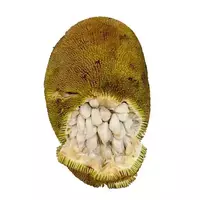Marang

On a par with such exotic fruits for Russia as jackfruit, champedak, durian and bread tree fruits, you can put another unusual fruit - marang. This plant also belongs to the fruit trees of the mulberry family. By the way, this fruit is also known under other, less common names - madang, tarap, cousin of breadfruit, green pedalai, johey oak and others.
The birthplace of this plant is southeast Asia, so we can say that it belongs to the rather heat-loving representatives of the natural world. Currently, countries such as Brunei, Indonesia, Malaysia, the Philippines and southern Thailand are considered the main exporters of marang. Most of the crop is used, usually for local consumption, which is directly related to the short shelf life of the fruits.
Meanwhile, the marang is a medium-sized evergreen tree, with a maximum height barely exceeding 25 meters. It is distinguished by the presence of large oblong leaves, the length of which often reaches half a meter. They resemble breadfruit leaves, but are slightly less dissected.
Marang fruit - can be described as a cross between jackfruit and breadfruit fruit. Fresh fruit is characterized by a strong smell and excellent taste, from where the name of the plant in Latin odoratissimus comes from, which literally means the most aromatic. Mature fruits are elongated in length up to 20 centimeters with an average weight of a kilogram.
On the thick skin of the marang there are a large number of soft spines that harden as the fruit matures. Moreover, the color of the fruit changes from dark green to yellowish green when ripening. The tender flesh of the mature marang, unlike the orange inside of the jackfruit, is white.
Basically, these fruits are usually consumed fresh not only as an independent dish, but also as a good component for numerous fruit salads and other desserts. However, it should be remembered that already cut fruit must be consumed very quickly, since oxidative processes in the fruit begin to occur immediately after violation of the integrity of the shell. So, the cut marang quickly loses its extraordinary aroma and can deteriorate in a few hours.
Large seeds of this exotic fruit are also suitable for food - they taste like a chestnut, so they become edible after heat treatment. They are mostly either fried or boiled.
Maranga 125 kCal
Energy value of marang (Ratio of proteins, fats, carbohydrates - ju):
Proteins: 2.5 g (~ 10 kCal)
Fats: 0.7 g (~ 6 kCal)
Carbohydrates: 27.3 g (~ 109 kCal)
Energy ratio (bj | y): 8% | 5% | 87%
 Español
Español Français
Français Português
Português Русский
Русский 简体中文
简体中文 繁體中文
繁體中文 日本語
日本語 한국어
한국어 العربية
العربية Türkçe
Türkçe Қазақ
Қазақ Deutsch
Deutsch Italiano
Italiano Українська
Українська
